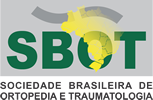Dados do Trabalho
Título / Title
Trans-metacarpophalangeal traction to avoid finger-related complications during wrist arthroscopy: Feasibility study with 20 cadaver wrists
Introdução / Introdution
The increased use of wrist arthroscopy has been accompanied by an increase in iatrogenic complications, some of which are directly related to the tension placed on the fingers: skin lesions, stretched ligaments, vascular and neurological disorders
Objetivo / Purpose
The aim of this work was to test whether trans-metacarpo- phalangeal (trans-MCP) traction will provide sufficient distraction of the radiocarpal and midcarpal joint spaces to perform wrist arthroscopy under satisfactory conditions, while avoiding the exertion of any mechanical stress on the fingers
Material e Método / Material and Methods
Our study included 20 cadaveric wrists (8 right and 12 left). These 20 wrists were mounted upright on a wrist arthroscopy traction tower with an eccentric column, maintained by Chinese finger traps placed on the 2nd and 4th fingers. The traction force was controlled by a mechanical dynamometer hook (FA20 Model1, Switzerland). A fluoroscopic machine (XISCAN Mini C-arm1) was set up horizontally to take pictures from the front. For each wrist, images were taken from the front: one without traction, one with finger traction and one with trans-metacarpal traction. On the first view, no extra weight was applied to the wrist. For the second view, continuous traction of 78.45 Newton (8 kg mass) was applied on the proximal phalange
Resultados / Results
The results were evaluated with Photoshop CS51 (AdobeTM) and consisted in measuring the height of the midcarpal and radiocarpal joint spaces on all three fluoroscopic views for all 20 wrists. The difference between the average height of the midcarpal joint space without traction (0.8305 cm) and the one with finger traction (1.037 cm) was significant (P < 0.001). The difference between the average height of the midcarpal joint space without traction (0.8305 cm) and the one with trans-MCP traction (1.1 cm) was significant (P < 0.001). The difference between the average height of the midcarpal joint space with finger traction (1.037 cm) and the one with trans-MCP traction (1.1 cm) was not significant (P < 0.07). The difference between the average height of the radiocarpal joint space with finger traction (1.187 cm) was not significant (P = 1)
Discussão / Discussion
Despite the limited iatrogenic complications directly related to finger traction reported in the literature, several techniques have been developed to avoid them
Conclusão / Conclusion
Our results show that trans-MCP traction results in opening of the radiocarpal and midcarpal joint space equivalent to that obtained with traction on the fingers
Palavras Chave / Keywork
Arthroscopy Distraction
Chinese finger traps
Área
ANATÔMICO
Instituições
Hand Surgery Department, Strasbourg University Hospitals, - - France, Hospital Samaritano São Paulo - São Paulo - Brasil
Autores
Phillippe Liverneaux, Luis Antonio Buendia, Hidalgo Diaz, G Asmar, S Hendricks, S Facca
Patrocinador Master


Patrocinador Ouro












